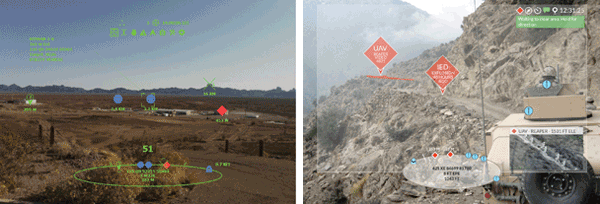There's more at the source, linked above.
“Often overlooked is the whole human-machine interface. That’s the biggest problem,” said Bharath Rajagopalan, general manager for business development and marketing at projection display maker MicroVision Inc. of Redmond, Wash. The company’s laser beam scanning technology can be incorporated into augmented reality products, including head-up and retinal scanning displays.
“We’ve been ready for a long time,”
Rajagopalan said of the company’s decade-old augmented reality technology. “We have good, sharp text. It’s very crisp, very readable, very high contrast.”
Originally developed for the military, MicroVision’s lightweight head-worn displays deliver images that appear to the user as though on a see-through computer screen – thus a technician can view instructions on jet engine repair while performing the task.
“We’ve been ready for a long time,”
Rajagopalan said of the company’s decade-old augmented reality technology. “We have good, sharp text. It’s very crisp, very readable, very high contrast.”
Originally developed for the military, MicroVision’s lightweight head-worn displays deliver images that appear to the user as though on a see-through computer screen – thus a technician can view instructions on jet engine repair while performing the task.

Originally developed for the military, augmented reality technology allows information to be displayed and shared outdoors. Photo courtesy of Applied Research Associates.
What’s needed in addition to a quality display is infrastructure, according to Rajagopalan, which includes access to data, sufficient computing power and the right software.
The payoff for getting the display and wearable package right has the potential to be big. Juniper Research Ltd., a Hampshire, U.K.-based analysis firm, predicted the wearable market will grow from its present value of a few hundred million to $80 billion by 2020. The firm expects over 3 million augmented reality smart glasses to be in business use by 2018; consumers will be slower to adopt the technology.
Steffen Sorrell, senior analyst at Juniper, noted that complex wearable augmented reality applications need a large field of view with high pixel density, and that the display must respond with an update latency of less than 20 milliseconds. For augmented reality, compromises in display performance or bulk are not acceptable, according to Sorrell.
The payoff for getting the display and wearable package right has the potential to be big. Juniper Research Ltd., a Hampshire, U.K.-based analysis firm, predicted the wearable market will grow from its present value of a few hundred million to $80 billion by 2020. The firm expects over 3 million augmented reality smart glasses to be in business use by 2018; consumers will be slower to adopt the technology.
Steffen Sorrell, senior analyst at Juniper, noted that complex wearable augmented reality applications need a large field of view with high pixel density, and that the display must respond with an update latency of less than 20 milliseconds. For augmented reality, compromises in display performance or bulk are not acceptable, according to Sorrell.

A laser scanning projection system by MicroVision. Photo courtesy of MicroVision.

No comments:
Post a Comment